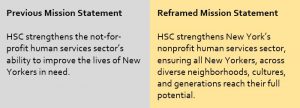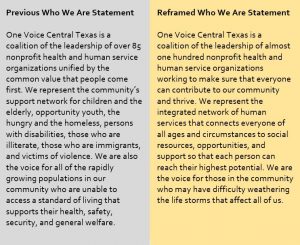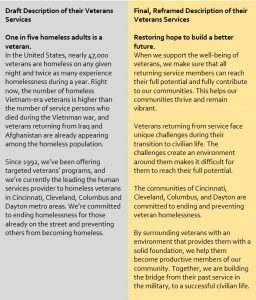Reframing newsletter Reframing Examples from the Field: Foundational Language
June 29, 2017
One of the most common requests we get from the Reframing Network is for examples of how peers in the human service sector are using the Building Well-Being Narrative. Over the next few newsletters, we’ll feature some of our favorite reframed communications from the past year.
This issue focuses on the communications pieces that lay the foundation for how organizations talk about themselves: Mission Statements; “About Us” language; and program or service descriptions. These are the pieces that we generally recommend organizations start with when they begin applying the Building Well-Being Narrative to their communications.
Some key lessons to keep in mind:
- Before telling people what your organization does, use the Value of Human Potential to tell them why.
- Be clear on the societal benefits of human services. Avoid terms like “vulnerable” and “needy” that can alienate the public by exacerbating beliefs that the sector is for other people, rather than something that we all benefit from.
- Avoid jargon. Instead, use the Construction Metaphor to explain what people need to do well and what systems can get in the way.
- Use Life Cycle Examples to normalize and expand on the public’s understanding of who may need to access services.
Here’s how three organizations applied these recommendations to their foundational communications. We hope the examples will inspire you and spark your own reframing creativity.
Mission Statements
When the
Human Services Council in New York reframed their Mission Statement, they shifted from a Mission Statement that relied on invoking compassion for those in need, to one that uses the more powerful value of Human Potential to define human services as something that we all benefit from across our life span.

About Us Statements
Where Mission Statements offer a quick, concise description of an organization’s purpose, “About Us” language provides more details and greater opportunities for incorporating the entire Building Well-Being Narrative. When
One Voice Central Texas reframed their
“Who We Are” language, they shifted away from listing vulnerable populations served to defining how everyone is connected to the “social resources, opportunities, and support” offered by human services. It incorporated the value of Human Potential to orient people to why they should care about human services, and the concept of “life storms” to normalize the reasons people access human services.

Program Descriptions
Volunteers of America of Greater Ohio was in the process of drafting a piece on their services for veterans when staff attended a reframing workshop at Volunteers of America’s National Conference. They generously shared their pre-workshop draft with us, which relied heavily on the kind of crisis language and unframed data that can leave the public feeling overwhelmed and helpless. Following the workshop, the staff at Volunteers of America of Greater Ohio rewrote the piece to incorporate what they learned. The final, reframed description relies on the value of Human Potential to convey that our communities do better when veterans thrive, and the Construction Metaphor to position the solutions for addressing the challenges that veterans face.




